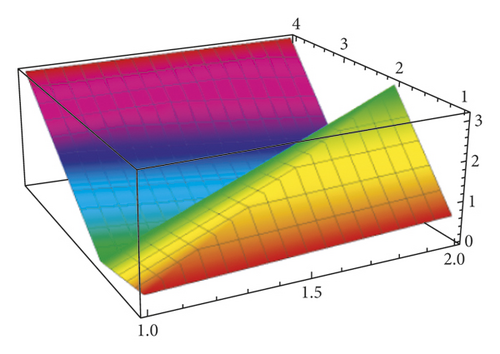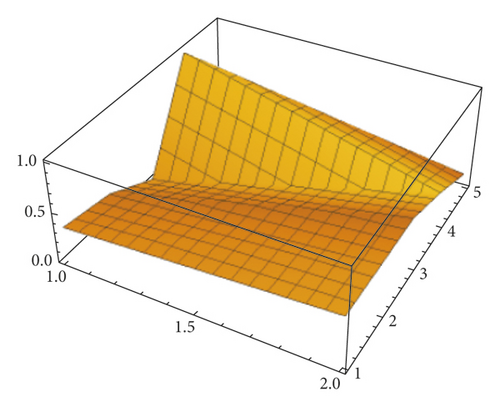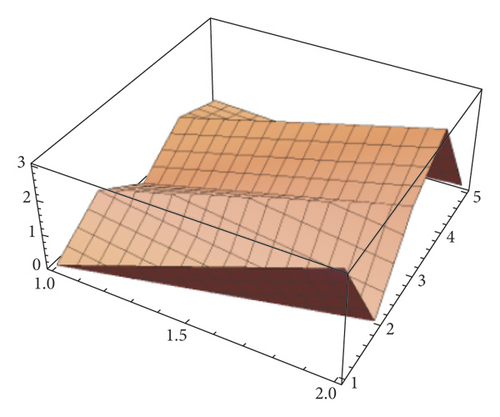On Some w−Interpolative Contractions of Suzuki-Type Mappings in Quasi-Partial b-Metric Space
Abstract
In this paper, our focus is to acquaint with the Suzuki-type mappings to establish some fixed point results using the new w-interpolative approach. We present some results for interpolative contraction operators via the w-admissible maps which satisfy the Kannan, Ćirić–Reich–Rus, and Hardy–Rogers contractions in quasi-partial b-metric space. Further, the outcomes so obtained are affirmed with relevant examples.
1. Introduction
In the early 20th century, Fréchet [1], a French mathematician, initiated the concept of metric space, and due to its efficiency and practicable implementations, the idea has been upgraded, improved, and generalized by many authors. In 1922, Banach [2] discovered a remarkable result, that is, Banach contraction principle, which holds a significant position in the field of nonlinear analysis. Later, Karapinar [3] introduced quasi-partial metric spaces which were followed by the discovery of b−metric spaces in 1993, by Czerwik [4]. Gupta and Gautam [5] generalized quasi-partial metric to quasi-partial b−metric space and proved some fixed point results for such spaces. After all these classical results, Suzuki [6] introduced a new type of mappings which generalized the well-known Banach contraction principle.
In 2014, the notion of w-orbital admissible maps was introduced by Popescu [7] which is a refinement of the concept of α-admissible maps of Samet et al. [8].
If the continuity of the involved contractive mappings is removed, we necessarily need (G, qpb) to be w-regular, i.e., if {ηn} is a sequence in (G, qpb) such that {ηn}⟶t ∈ G as n ⟶∞ and w(ηn, ηn+1) ≥ 1 for each n, then we have w(ηn, t) ≥1.
We show that the condition of w-regularity holds in quasi-partial b-metric space by using w-admissibility condition. In our earlier work [9], we have shown that w-admissibility holds in quasi-partial b-metric space, i.e., w(ηn, Sηn) ≥ 1; then, as n ⟶∞, we get {ηn}⟶t, and hence we get the condition for w-regularity.
Throughout the paper, R+, N, and ϕ stand for the set of positive real numbers, natural numbers, and an empty set, respectively. Let Ψ be the set of all nondecreasing self-mappings ψ on [0, ∞) such that for every η > 0. Notice that for Ψ ∈ ψ, we have ψ(0) = 0 and ψ(η) < η for all η > 0 (see [10]).
2. Preliminaries
Definition 1 (see [5].)A function qpb : G × G ⟶R+ is said to be a quasi-partial b-metric on a nonempty set G if it satisfies the properties
- (1)
qpb(η, η) = qpb(η, ζ) = qpb(ζ, ζ) implies η = ζ;
- (2)
qpb(η, η) ≤ qpb(ζ, η);
- (3)
qpb(η, η) ≤ qpb(η, ζ);
- (4)
qpb(η, ζ) ≤ s[qpb(η, σ) + qpb(σ, ζ)] − qpb(σ, σ),
Definition 2 (see [5].)Suppose (G, qpb) is a quasi-partial b-metric space. Then,
- (1)
A sequence {ηn} is called a Cauchy sequence if and only if limn,m⟶∞qpb(ηn, ηm) and limn,m⟶∞qpb(ηm, ηn) exist finitely.
- (2)
A sequence {ηn} ⊂ G converges to η ∈ G if and only if qpb(η, η) = limn⟶∞qpb(η, ηn) = limn⟶∞qpb(ηn, η).
- (3)
(G, qpb) is said to be complete if every Cauchy sequence {ηn} ⊂ G converges with respect to to a point η ∈ G that holds
(2) - (4)
A mapping f : G⟶G is said to be continuous at η0 ∈ G if for every ε > 0, there exists δ > 0 such that f(B(η0, δ)) ⊂ B(f(η0), ε).
Definition 3 (see [9].)Suppose (G, qpb) is a quasi-partial b-metric space. A self-map S : G⟶G is known as a w-interpolative Ćirić–Reich–Rus contraction if there exist λ ∈ ψ and a map w : G × G⟶[0, ∞] with real numbers α, β > 0, satisfying α + β < 1, that holds
Definition 4 (see [11].)Suppose (G, qpb) is a quasi-partial b-metric. Define a self-mapping S : G⟶G and a map w : G × G⟶[0, ∞) where λ ∈ ψ that holds
Definition 5 (see [10].)A mapping S is said to satisfy C-condition on (G, qpb), if it satisfies
Throughout the paper, qpb and Cqpb denote the quasi-partial b-metric space and complete quasi-partial b-metric space, respectively. One can see for more related point results in [12–15] and the references therein.
3. Main Results
We now define the main results for Suzuki-type mappings using the notion of w-interpolation (see 16, 17) and the fact that the condition of w-regularity holds in quasi-partial b−metric space (see 18–20]).
Definition 6. Let (G, qpb) be a quasi-partial b-metric space and there exists a self-map w : G × G⟶ [0, ∞) with a real number α ∈ [0, 1). A self-map S : G⟶G is said to be a w-ψ-interpolative Kannan contraction of Suzuki type if there exist ψ ∈ Ψ that satisfies
Theorem 1. Suppose (G, qpb) is a Cqpb and S : G⟶G is a w-ψ-interpolative Kannan contraction of Suzuki type. Let S be a w-orbital admissible map and w(η0, Sη0)≥ 1 for some η0 ∈ G. Then, S possesses a fixed point in G if any of the following conditions hold:
- (1)
(G, qpb ) is w-regular.
- (2)
S is continuous.
- (3)
ψS2 is continuous and w(η, Sη)≥ 1 when η ∈ Fix(S2).
Proof. Let η0 ∈ G with the condition w(η0, Sη0)≥ 1 and {ηn} be the sequence such that Sn(η0) = ηn for each positive integer n. For some η0 ∈ N, we have . Hence, we get = , so is a fixed point of S. Hence, the proof is complete.
On the contrary, take ηn ≠ ηn+1 for every positive integer n. As S is w-orbital admissible, we have the condition w(η0, S η0) = w(η0, η1) ≥ 1 which implies that w(η1, S η1) = w(η1, η2) ≥ 1. Proceeding in a similar way, we get
Hence, choosing η = ηn−1 and ζ = S ηn−1 in (6) gives
Hence, we have
Thus, we get that {qpb(ηn−1, ηn)} is a nonincreasing sequence of positive terms, so there exists l≥ 0 such that limn⟶∞ qpb(ηn−1, ηn) = l. On the other hand, from the above equations and the nondecreasing nature of function ψ, we obtain
By triangular inequality, for all j ≥ 1, we get
Hence, {ηn} is a Cauchy sequence and using the completeness property of qpb space, it shows that there exists t ∈ G such that
Also, we claim that S possesses a fixed point as t.
In the case when assumption (1) holds true, we have w(ηn, t)≥ 1 and we claim that
If the second condition holds, we get
Therefore, letting n ⟶∞, we get qpb(t, St) = 0, that is, t = St.
In the case when assumption (2) holds, we have that the mapping S is continuous, so we get
In the case when assumption (3) holds, we have ψS2t = ψlimn⟶∞S2ηn = ψlimn⟶∞ηn+2 = ψt and we prove that St = t. On the contrary, take St ≠ t; then,
By (6), we get
Hence, it is a contradiction. Thus, t = St, that is, t is a fixed point of the mapping S.
Example 1. Let G = [0, π/4] and define qpb : G × G⟶ [0, ∞) such that
Define a self-mapping S : G⟶G as
Also, define w : G × G⟶ [0, ∞) such that
Choose α = 1/3 and define the function ψ ∈ Ψ as ψ(η) = 2η/3. The only case we need to verify is when η = π/9 and ζ = π/5; as for the remaining cases, we have w(η, ζ) = 0, which clearly implies that inequality (6) holds. So, when η = π/9 and ζ = π/5, we get
Hence, all the assumptions of Theorem 1 are satisfied, which follows that the mapping S owns a fixed point, that is, η = π/9, as shown in Figure 1.

Corollary 1. Let (G, qpb) be a C qpb and S be a self-map on G, satisfying
Proof. For the proof, take w(η, ζ) = 1 in Theorem 1.
Corollary 2. Let (G, qpb) be a C qpb and S be a self-map on G, satisfying
Proof. For the proof, take ψ(η) = ηg, with g ∈ [0, 1) and η> 0 in Corollary 1.
Definition 7. Suppose (G, qpb) is a quasi-partial b-metric space. Define a self-mapping S : G⟶G such that there exist ψ ∈ Ψ satisfying
Theorem 2. Suppose (G, qpb) is a C qpb and S : G⟶G is a w-ψ-interpolative Ćirić–Reich–Rus contraction of Suzuki type. Let S be a w-orbital admissible map and w(η0, Sη0) ≥ 1 for some η0 ∈ G. Then, S possesses a fixed point in G if any of the conditions hold:
- (1)
(G, qpb) is w-regular.
- (2)
S is continuous.
- (3)
ψS2 is continuous and w(Sη, η)≥ 1 when η ∈ Fix(S2).
Proof. Let η0 ∈ G with the condition w(η0, Sη0)≥ 1 and {ηn} be the sequence such that Sn(η0) = ηn for each positive integer n. Assume that for some η0 ∈ N, we have the condition . Hence, we get = S , which implies is the fixed point of S. So, the proof is complete.
On the contrary, take ηn ≠ ηn+1 for each positive integer n. Since S is w-orbital admissible, we have w(η0, S η0) = w(η0, η1) ≥ 1, which implies that w(η1, S η1) = w(η1, η2) ≥ 1. Proceeding similarly,
Hence, choosing η = ηn−1 and ζ = S ηn−1 in (30), we get
Then, using ψ(η) < η for every η > 0, we get
So, we get
Hence, it shows that {qpb(ηn−1, ηn)} is a decreasing sequence. Eventually, we have
In a similar way, we get
Since {ηn} is a fundamental sequence, applying triangular inequality, we get
Taking n ⟶∞, we deduce that {ηn} is a fundamental sequence in qpb and by the completeness property of qpb, there exists t ∈ G satisfying
If assumption (1) holds, then we have w(ηn, t)≥ 1 and we claim that
Hence, the contradiction occurs. Therefore, for every n ∈ N, our claim holds. If the first condition holds, we obtain
If the second condition holds true, clearly t is the fixed point of S in a similar manner. Furthermore, if the w-regular condition is removed and S is a continuous map, we get a fixed point in G because
Finally, if the last condition holds, i.e., ψS2 is continuous, we easily obtain ψS2 = ψt. Suppose on the contrary that St ≠ t, since w(Sη, η)≤ 1 for any η ∈ Fix (S2) and
We have
Example 2. Suppose G = {0, 1/4, 1/3, 1/2, 1} and define qpb : G × G⟶ [0, ∞) such that
Let the transformation S : G⟶G maps as follows:
Also, define w : G × G⟶ [0, ∞) such that
Choose α = β = 1/3 and define the function ψ ∈ Ψ as ψ(η) = η/2. We need to check when w(η, ζ) = 1. So, the following cases occur.
Case 1. When (η, ζ) = (0, 1),
Case 2. When (η, ζ) = (0, 1/3),
Case 3. When (η, ζ) = (1, 0),
Hence, all the assumptions of Theorem 2 are satisfied, and it follows that the mapping S owns a fixed point, that is, η = 1/3, as shown in Figure 2.

Definition 8. Let (G, qpb) be a quasi-partial b-metric space. Define a self-mapping S : G⟶G with ψ ∈ Ψ satisfying
Corollary 3. Suppose (G, qpb) is a C qpb and S is a ψ-interpolative Ćirić–Reich–Rus contraction of Suzuki type. Then, S owns a fixed point in G.
Proof. For the proof, take w(η, ζ) = 1 in Theorem 2.
Corollary 4. Suppose (G, qpb) is a C qpb and S is an interpolative Ćirić–Reich–Rus contraction of Suzuki type if there exist g ∈ [0, 1) and positive reals α, β > 0, with α + β < 1 such that
Proof. In Theorem 2, it is sufficient to put ψ(η) = gη, for all η> 0 and g ∈ [0,1), for the proof.
Definition 9. Let (G, qpb) be a qpb space and define a map w : G × G⟶ [0, ∞). A mapping S : G⟶G is w-ψ-interpolative Hardy–Rogers contraction of Suzuki type if there exists ψ ∈ Ψ with real numbers α, β, γ > 0, holding α + β + γ < 1 such that
Theorem 3. Suppose (G, qpb) is a C qpb and S : G⟶G is a w − ψ-interpolative Hardy–Rogers contraction of Suzuki type. Let S be a w-orbital admissible mapping and w(η0, S η0) ≥ 1 for some η0 ∈ G. Then, S possesses a fixed point in G if any of the conditions hold:
- (1)
(G, qpb) is w-regular.
- (2)
S is continuous.
- (3)
ψS2 is continuous and w(S η, η) ≥ 1 when η ∈ Fix (S2).
Proof. Let η0 ∈ G with the condition w(η0, S η0) ≥ 1 and {ηn} be the sequence such that Sn(η0) = ηn for each positive integer n. Assume that for some η0 ∈ N, we have the condition . Hence, we get = S which implies is a unique fixed point of S. Hence, the proof is complete.
Now, consider ηn ≠ ηn+1 for each positive integer n. As S is w-orbital admissible, we have the condition w(η0, S η0) = w(η0, η1) ≥ 1 which implies that w(η1, S η1) = w(η1, η2) ≥ 1. Proceeding in a similar way, we get
Choosing η = ηn−1 and ζ = S ηn−1 in (58), we get
Then, using ψ(η) < η for every η > 0, we get
Hence, {qpb(ηn−1, ηn)} is a decreasing sequence. Eventually, we have
In a similar way, we get
Since {ηn} is a fundamental sequence, applying triangular inequality,
Taking n ⟶∞, we deduce that {ηn} is a fundamental sequence in qpb space and by the completeness property of qpb, there exists t ∈ G satisfying
Now we show that t is the fixed point of S. If assumption (1) holds true, then we have w(ηn, t)≥ 1 and we claim that
If assumption (2) holds, we get that t is the fixed point of S in a similar manner. Furthermore, if the w-regular condition is removed and S is continuous, then we get that S owns a unique fixed point in G because
Finally, if the last condition holds, i.e., ψS2 is continuous, we easily obtain ψS2 = ψt. Suppose on the contrary that St ≠ t, since w(Sη, η) ≤ 1 for any η ∈ Fix (S2) and
We have
Definition 10. Let (G, qpb) be a quasi-partial b-metric space. A mapping S : G⟶G is said to be a ψ-interpolative Hardy–Rogers contraction of Suzuki type if there exist ψ and α, β, γ > 0, with the condition α + β + γ < 1 such that
Corollary 5. Let (G, qpb) be a C qpb and S be a ψ-interpolative Hardy–Rogers contraction of Suzuki type. Then, the mapping S possesses a fixed point in G.
Proof. For the proof, take w(η, ζ) = 1 in Theorem 3.
Example 3. Let G = [0, 3] and define qpb : G × G⟶ [0, ∞) such that
Let the mapping S : G⟶G be defined as
Also, define w : G × G⟶ [0, ∞) such that
Choose α = β = γ = 1/4 and define the function ψ ∈ Ψ as ψ(η) = η/3. For η, ζ ∈ [0, 2), we have w(η, ζ) = 0, which clearly implies that inequality (58) holds. As per the definition of function w, the only case left is when we have η = 0 and ζ = 3 as w(η, ζ) = 1, so

4. Conclusion and Future Aspects
The paper propounds the idea of using interpolation in noteworthy Suzuki-type mappings in the quasi-partial b-metric space. The incentive behind the paper was to introduce new concepts on completeness of w-ψ-interpolative Kannan, Ćirić–Reich–Rus, and Hardy–Rogers contractions of Suzuki-type mappings in quasi-partial b-metric space. Further, some fixed point results are obtained and are validated by illustrative examples. Interpolation is a noble concept which can be utilized to obtain different interpolative contraction of Suzuki-type mappings in other well-known spaces in the future. We are certain that the paper is a significant improvement of the known results in the existing fixed point literature.
Conflicts of Interest
The authors declare that they have no conflicts of interest.
Authors’ Contributions
All authors contributed equally and significantly in writing this article. All authors read and approved the final manuscript.
Open Research
Data Availability
No data were used to support this study.




